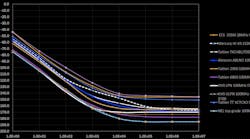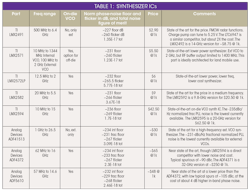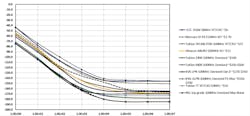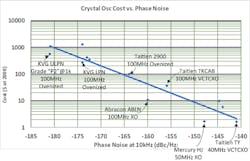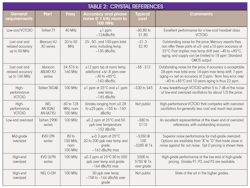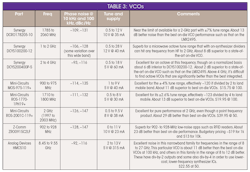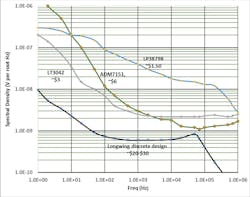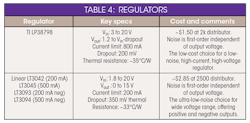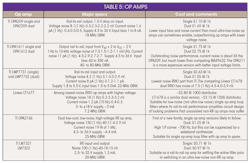Series: Ultra-Low-Noise Synthesizer Design
Download this article in PDF format.
Welcome to Part 4 of this 5-part series on ultra-low-noise synthesizer design. Part 1 introduced advanced loop design and included both passive and active filters. Part 2 covered noise sources in the loop outside of the synthesizer integrated circuit (IC). Part 3 added synthesizer IC noises and how they are modeled, as well as how all of the noise sources are combined and shaped by the loop.
This article covers the key parts required by design engineers seeking the lowest-noise designs, or lowest noise for a particular cost. Since the designer is naturally concerned with the cost tradeoffs of these key parts, that information is presented in some detail here. Additional information is available in the long version posted on the Longwing Technology website. Part 5 will bring it all together in the form of low-noise examples, comparing and contrasting the performance attained by the various methods and the available parts.
Key Components
Major Trends
The most significant trend driving lower noise in modern single-loop synthesizers is the development of the delta-sigma synthesizer IC in very high-speed IC processes. This synthesizer approach allows for fractional-N synthesis with real number multiplication of the reference frequency. A key breakthrough is that high fractional resolution allows for high-frequency references. This, in turn, enables high bandwidth for maximum noise suppression inside a much wider loop bandwidth than integer synthesizers allow for, i.e., bandwidths may now exceed 400 kHz.
Another important factor is associated with using multiple voltage-controlled oscillators (VCOs) on die combined with hundreds of narrowband resonators (Ref. 5). In this scenario, which emulates wideband VCOs to hit any frequency by use of frequency division, the on-die noise performance past the loop bandwidth in offset and above about 4 GHz in VCO frequency can generally match or beat the best octave-bandwidth discrete VCOs.
The best octave-bandwidth VCOs below 4 GHz can currently outperform on-die narrowband emulations of wideband VCOs by about 2 to 8 dB, while the best narrowband VCOs can exceed on-die performance by 10 to 30 dB. It’s thus mostly in the narrowband VCO case, and in applications in which noise past the loop bandwidth of typically about 50 to 400 kHz is critical, where discrete VCOs still find success.
Integer-N synthesizer crystal references in the past were usually in the range of 1 to 20 MHz (10 MHz being a popular choice), with divided frequency steps typically in the range of 1 to 200 kHz as per system requirements. However, the capability of the fractional-N synthesizer to effectively hit any frequency with only small error allows for the use of higher-frequency references.
Crystal oscillators as high as 100 MHz are now becoming available at cost-effective prices, and many synthesizers enable internal doubling to 200 MHz to allow for even higher loop bandwidths. The need to support ultra-low-noise VCOs and crystal oscillators also led to lower-noise voltage regulators to supply them.
Synthesizer ICs
Among the key issues associated with choosing modern delta-sigma synthesizers are internal noise parameters, which model the noise that the charge pump and dividers induce on the VCO in the closed-loop state. These are further described in the long form of this article, and in still more detail in Part 3 of this series (Ref. 3). The parameters are modeled as a flat and 1/f noise term for each part.
When using a device in fractional mode, the in-band phase noise may be slightly degraded, depending on the fraction and how it’s expressed. This fractional noise floor appears to add to the integer noise floor modeled by the term PN1Hz. Some manufacturers, such as Analog Devices (ADI), may account for this by increasing PN1Hz by a modest amount, which may be 1 to 3 dB in fractional mode.
In Part 3, a figure of merit combining the noises of the flat and 1/f terms is developed. Results of this combination are shown in Table 1. This figure of merit is proportional to synthesizer-chip-induced noise power from 1 Hz to a bandwidth of fL. Therefore, smaller is better.
Listed are leading delta-sigma synthesizer ICs. Lower noise is more expensive, but lower noise combined with higher frequency is what really costs. Note: Texas Instruments reports no difference in broadband phase noise between integer and fractional mode, though spurs may vary. Analog Devices typically reports a difference in integer and fractional mode normalized noise, in which fractional is about 1 to 3 dB noisier.
Crystal References
In the case of the modern delta-sigma, fractional-N, high-bandwidth synthesizer, the crystal reference oscillator is the component that can often be the most expensive and have the greatest impact in the system. Phase noise is considered at offsets from the carrier on a per-Hz basis. Inside the loop bandwidth, there will typically be a range of frequencies in which the synthesizer-chip noise parameters set the phase-noise floor, as well as a lower range of frequencies in which the multiplied crystal oscillator noise is dominant over the chip noise. Understanding the tradeoffs here can significantly affect the total cost.
Figure 1 shows the phase-noise performance of a set of commercially available crystal reference oscillators that, under different conditions, are all well-suited for modern usage. Though these are all low-noise oscillators for their price, there’s a phase-noise variation of approximately 30 to 40 dB. Even more striking is the price variation, which varies from less than $2 to over $1,000.
1. Shown are example phase noises for crystal oscillators displaying excellent noise performance. These commercially available parts operate from 28 to 100 MHz; here, they are normalized to 100-MHz noise performance for fair comparison.
For decades, 10 MHz was the standard frequency of the finest low-noise crystal oscillators. However, 100 MHz is rapidly becoming a new standard for this application, with both voltage-controlled temperature-compensated crystal oscillators (VCTCXOs) and ovenized oscillators now available. Lower-cost simple crystal oscillators will typically have 10 to 100 parts per million (ppm) accuracy and temperature drift. This performance, if acceptable, can lead to quite good noise performance for prices ranging from less than $2 to about $12.
VCTCXOs offer frequency accuracy from about 0.5 to 2 ppm. VCTCXOs at frequencies under 40 MHz with phase noise suitable for wireless handsets (typically consuming less than 3 mA) are available for less than $2 and sometimes less than $1 in high volumes. At 40 MHz and with performance suitable for base stations, price ranges from about $4 to $8.
However, newly released VCTCXOs at 100 MHz (Taitien, TKCAB) that are ideal for the latest synthesizer ICs aimed at high-performance communications, wireless infrastructure, and test equipment are tending to be in the price range of $25 to $40. For the most demanding applications, ovenized oscillators at 100 MHz with initial frequency accuracy from 0.2 to 0.5 ppm and very well-controlled aging and temperature drift range cost about $70 to $1500. However, outstanding performance can be obtained by the careful designer for about $250 to $500. The price-performance ratios may be visualized by Figure 2.
2. This approximate price-versus-noise-performance graph of well-performing crystal oscillators, with trend line curve fit, gives a designer a quick view in terms of what must be spent to obtain certain phase-noise performance.
This dB linear graph shows that the general cost versus phase-noise function is an approximate hyperbola, which is quantified and discussed in more depth in the long version at www.longwingtech.com. The main takeaway is that there’s a predictable relationship here to help the designer understand a fair market price for the specifications needed. More details of examples of good performance-price ratio crystal oscillators are reviewed in Table 2.
Listed are strong crystal oscillator candidates for low-noise synthesizers. Costs reflect moderate to medium volume for the typical applications of the part, and in some cases are estimated by the author.
Crystal-Reference Drive and Buffering
This subject is insufficiently reported on, and often more difficult than it seems at first glance. These synthesizer inputs have demanding slew-rate requirements for best noise performance, may have matching requirements, and often have some surprising voltage requirements. A voltage peak-to-peak swing above a minimum is needed, but usually also with a maximum that’s less than the synthesizer chip supply rails. This is reviewed in some depth in the long version at www.longwingtech.com with recommended buffer parts.
There’s a disconnect here in the market between optimum drive for different synthesizers and what crystal oscillators typically provide; therefore, users may have to provide their own buffering. It’s a surprisingly important issue, as phase-noise degradation exceeding 10 dB can occur.
Discrete VCOs
Low-noise VCOs have historically been provided as modules by companies that were specialists in pushing Leeson’s Equation (Ref. 2) to the limits of physics and parts, which required high-Q resonators and a detailed understanding of all noise sources in a VCO. To remain relevant with on-die VCOs taking an ever-increasing market share, new even lower-noise VCOs have continued to come out. Such products include the narrowband VCOs offered by Mini-Circuits, Synergy Microwave, Z-Comm, and Analog Devices.
The best narrowband VCOs have about 10- to 30-dB better noise performance than the best on-die VCOs. Synergy Microwave, with its metamaterial resonator VCOs, offers octave-bandwidth VCOs to about 4 GHz with phase noise that’s within about 5 to 20 dB of the very best narrowband VCOs at similar frequencies, and typically about 2 to 8 dB superior than the finest on-die VCOs. Though on-die VCOs are probably taking over 80% of design-ins, high-performance discrete VCOs are still finding application in microwave links, test equipment, military communications, and wireless infrastructure. Some key examples are given in Table 3.
These are noteworthy VCO candidates for low-noise synthesizers. While noise well inside the PLL bandwidth will be similar to that of integrated VCOs, these parts can provide significantly lower phase noise around and past the loop bandwidth.
Power Supplies
Low-noise regulators represent an area of important recent advancement. Noise on supplies will directly modulate noise on a VCO, as described in Part 2 of this series. As recently as 2010, a noise floor of about 10 to 30 nV per root Hz was considered “ultra-low noise.” These levels could induce considerable degradation of the phase noise of a low-noise VCO.
For this reason, the author had previously designed custom discrete regulators with floor of 1 nV or lower when such performance was needed. In 2015, noises as low as 2 nV were introduced to the market by Linear Technology in very convenient form. For the majority of applications, a supply noise level of 2 nV per root Hz eliminates supply noise as a practical concern.
3. Ultra-low noise regulator spectral noise density is compared in this plot. The LT3042 and ADM7151 noise curves were both obtained with 22-µF noise-filter capacitances.
Regulator noises for four top options are shown in Figure 3. In the author’s opinion, the most usable low-noise regulator on the market is the 2-nV-floor LT3042 from Linear Technology (now Analog Devices). It provides voltages of 0 to 15 V at up to 200-mA output. The new LT3045 provides up to 500 mA. In addition, the recently introduced LT3093 and LT3094 deliver similar performance in negative voltage regulator form. Table 4 shows key specifications of several top low-noise regulator choices.
Listed are key specifications of several top low-noise regulator choices.
Low-Noise Op Amps
Op amps are needed to boost charge-pump outputs to the higher voltages required to tune the very finest discrete VCOs. However, their noise will directly modulate noise onto the VCO output and must be very low to be transparent (Ref. 2). Op amps with noise floors approaching 1 nV have been available for many years. In recent years, though, these op amps have improved with lower input current (important for low spurs) and current noise (also very important), greater common-mode range, and higher bandwidth (important to spurs and phase shift).
However, the very lowest-noise op amps are not rail to rail, and care must be taken when locking the phase-locked loop (PLL) using these op amps. Typical methods of working with non-rail-to-rail op amps are to make use of a low-noise negative supply for the op amp, pre-charge the loop filter under software control to be within the input voltage range of the op amp, or switch in a rail-to-rail op amp during initial settling. Table 5 lists low-noise op amps for use in low-noise synthesizers.
Listed are low-noise op amps for use in low-noise synthesizers. The shorthand W-X-Y-Z here refers to spectral noise density (voltage or current) at frequencies spaced a decade apart, usually starting at 1 Hz.
Summary
Delta-sigma synthesizer ICs with on-die VCOs and output dividers have reshaped the design of synthesizers in the last decade. Available at frequencies as high as 32 GHz, they can typically provide any output frequency from a few tens of MHz to their upper frequency limit. The inherent higher phase noise of on-die VCOs has been partially tamed by switching VCOs and resonators for the best open-loop on-die VCO phase noise, and then suppressing that noise with high-frequency crystal oscillators and higher phase-detector frequencies to allow for higher loop bandwidths out to approximately 200 to 400 kHz.
Discrete-VCO-based synthesizers can still offer the advantage of superior phase noise around and past the loop bandwidth. For the best narrowband and point frequency VCOs, this advantage is quite significant (about 20 to 30 dB). For octave-bandwidth VCOs that offer similar frequency flexibility to on-die VCOs, the advantage is more limited—about 2 to 8 dB for VCOs under 4 GHz.
The discrete VCO approach currently pays a penalty of moderately higher noise (approximately 3 to 4 dB) over part of the range within the loop bandwidth due to the best PLL noise (charge pump and divider noise) being available only for VCO on-die synthesizers and not for synthesizers supporting external VCOs. The discrete VCO approach also requires extra parts for higher voltage supplies and active loop filters. Still, in markets like test equipment, microwave links, wireless infrastructure, and low-noise communications, there are places for the discrete VCO approach. Examples will be shown in the concluding fifth article of this series.
Acknowledgements
The author wishes to express his appreciation for the information and reviews provided by Dean Banerjee at Texas Instruments, Marty Richardson at Analog Devices, Miguel Troester and C.Y. Teng at Taitien, Harald Rudolf at KVG Quartz Crystal Technology, and Daniel Loomis at Z-Communications.
Series: Ultra-Low-Noise Synthesizer Design
Farron Dacus is an RF design consultant in Dallas, Texas. He received his BSEE and MSEE from the University of Texas, and has over 30 years of experience ranging from ICs to circuits to systems in low-noise RF, short-range radio / IoT, cellular, military communications, and aircraft radios. He may be reached at [email protected].
References
1. “Design Methods of Modern Ultra-Low Noise Synthesizers,” Farron Dacus, Microwaves & RF, Dec. 2018.
2. “Noise Sources in Ultra-Low-Noise Synthesizer Design,” Farron Dacus, Microwaves & RF, Feb. 2019.
3. “Noise and its Shaping in Ultra-Low-Noise Synthesizer Design,” Farron Dacus, Microwaves & RF, Mar. 2019. Long forms of these articles with more detail are posted at www.longwingtech.com.
4. “Supply clean power with ultra-low-noise LDO regulators,” Steve Knoth, Electronic Products.
5. “A 2-to-16GHz BiCMOS ΔΣ Fractional-N PLL Synthesizer with Integrated VCO’s and Frequency Doubler for Wireless Backhaul Applications,” Tino Copani et. al., STMicroelectronics, 2016 ISSCC. Available from the IEEE.
